The Ethics of Deinstitutionalization and Mental Health Care
VerifiedAdded on 2020/04/07
|12
|4189
|50
Essay
AI Summary
This essay delves into the ethical considerations surrounding mental health, focusing on the impact of deinstitutionalization and societal perceptions. It examines the historical context of deinstitutionalization, the scientific and societal changes that led to it, and the mixed reviews it has received. The essay analyzes the components of deinstitutionalization, including the release of patients from psychiatric hospitals, the provision of community-based care, and the challenges of ensuring adequate support for individuals with mental illnesses. It discusses the statement made by a member of Parliament regarding the closure of mental institutions and its implications for the stigma and discrimination faced by the mentally ill. Furthermore, the essay explores the importance of providing comprehensive and intensive care in community settings and the need for a nuanced approach to mental health care that considers individual needs and the limitations of deinstitutionalization. The essay concludes by emphasizing the importance of addressing the ethical dimensions of mental health care and the need for continued efforts to improve the quality of life for individuals with mental illnesses.
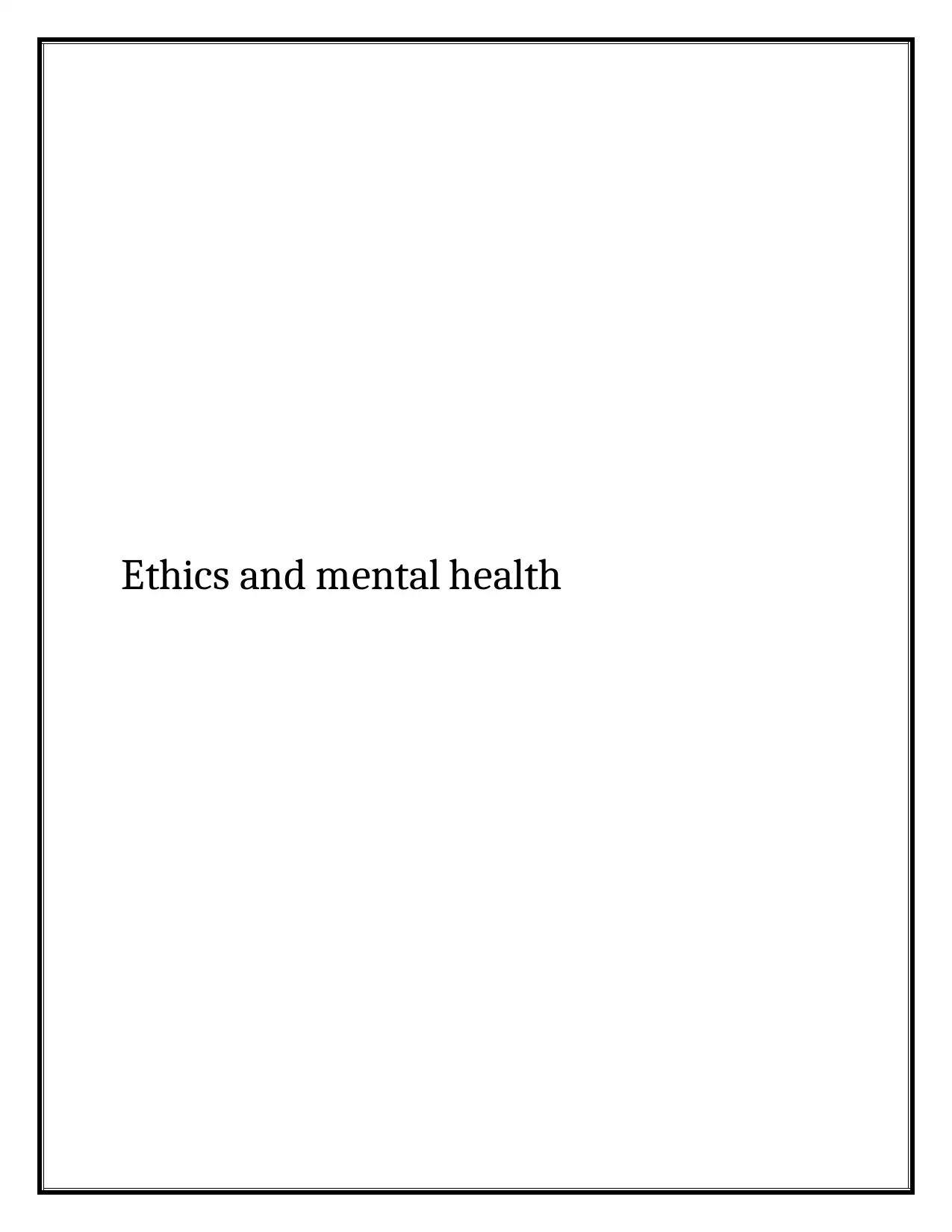
Ethics and mental health
Paraphrase This Document
Need a fresh take? Get an instant paraphrase of this document with our AI Paraphraser

Contents
ABSTRACT....................................................................................................................................2
INTRODUCTION...........................................................................................................................2
BODY..............................................................................................................................................3
CONCLUSION................................................................................................................................7
REFERENCES................................................................................................................................8
ABSTRACT....................................................................................................................................2
INTRODUCTION...........................................................................................................................2
BODY..............................................................................................................................................3
CONCLUSION................................................................................................................................7
REFERENCES................................................................................................................................8
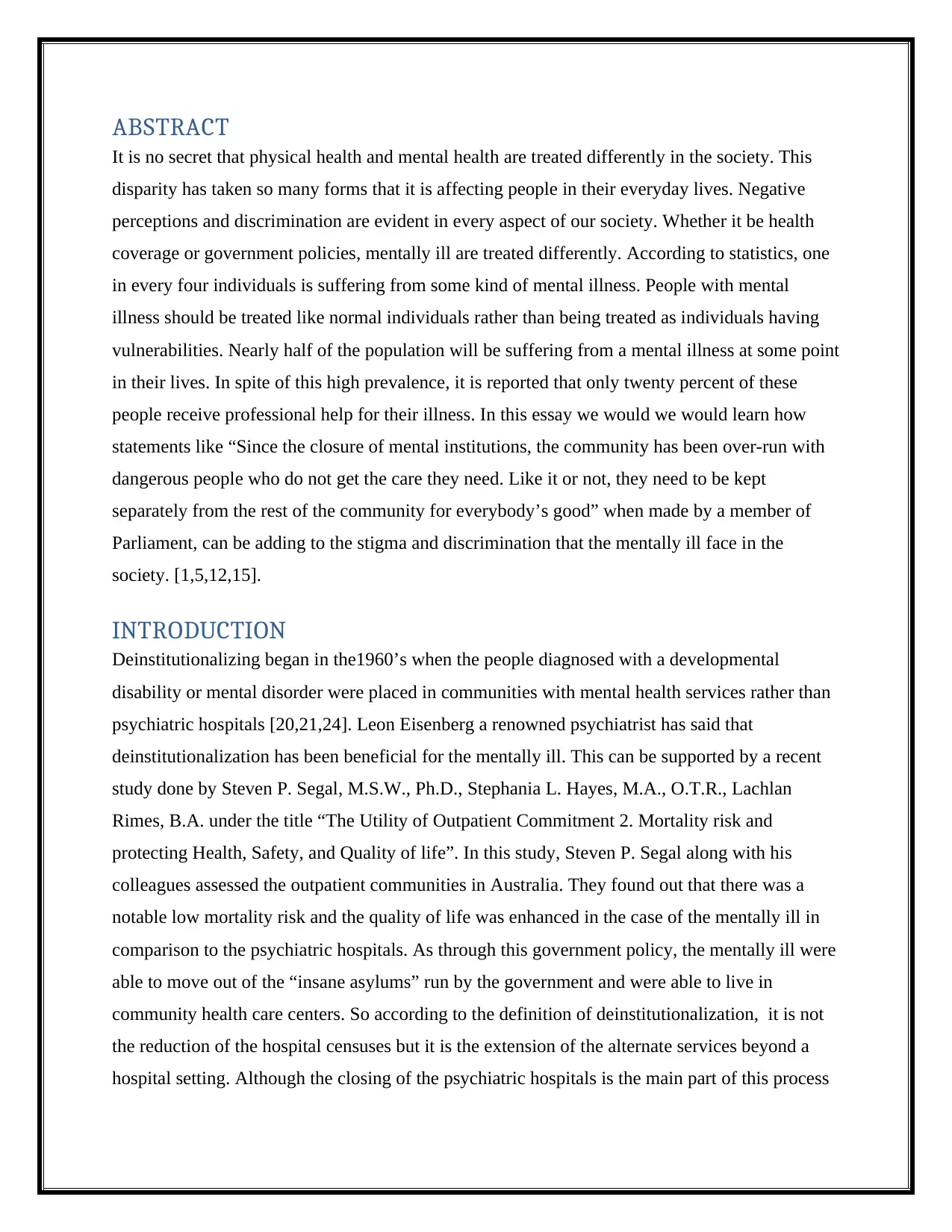
ABSTRACT
It is no secret that physical health and mental health are treated differently in the society. This
disparity has taken so many forms that it is affecting people in their everyday lives. Negative
perceptions and discrimination are evident in every aspect of our society. Whether it be health
coverage or government policies, mentally ill are treated differently. According to statistics, one
in every four individuals is suffering from some kind of mental illness. People with mental
illness should be treated like normal individuals rather than being treated as individuals having
vulnerabilities. Nearly half of the population will be suffering from a mental illness at some point
in their lives. In spite of this high prevalence, it is reported that only twenty percent of these
people receive professional help for their illness. In this essay we would we would learn how
statements like “Since the closure of mental institutions, the community has been over-run with
dangerous people who do not get the care they need. Like it or not, they need to be kept
separately from the rest of the community for everybody’s good” when made by a member of
Parliament, can be adding to the stigma and discrimination that the mentally ill face in the
society. [1,5,12,15].
INTRODUCTION
Deinstitutionalizing began in the1960’s when the people diagnosed with a developmental
disability or mental disorder were placed in communities with mental health services rather than
psychiatric hospitals [20,21,24]. Leon Eisenberg a renowned psychiatrist has said that
deinstitutionalization has been beneficial for the mentally ill. This can be supported by a recent
study done by Steven P. Segal, M.S.W., Ph.D., Stephania L. Hayes, M.A., O.T.R., Lachlan
Rimes, B.A. under the title “The Utility of Outpatient Commitment 2. Mortality risk and
protecting Health, Safety, and Quality of life”. In this study, Steven P. Segal along with his
colleagues assessed the outpatient communities in Australia. They found out that there was a
notable low mortality risk and the quality of life was enhanced in the case of the mentally ill in
comparison to the psychiatric hospitals. As through this government policy, the mentally ill were
able to move out of the “insane asylums” run by the government and were able to live in
community health care centers. So according to the definition of deinstitutionalization, it is not
the reduction of the hospital censuses but it is the extension of the alternate services beyond a
hospital setting. Although the closing of the psychiatric hospitals is the main part of this process
It is no secret that physical health and mental health are treated differently in the society. This
disparity has taken so many forms that it is affecting people in their everyday lives. Negative
perceptions and discrimination are evident in every aspect of our society. Whether it be health
coverage or government policies, mentally ill are treated differently. According to statistics, one
in every four individuals is suffering from some kind of mental illness. People with mental
illness should be treated like normal individuals rather than being treated as individuals having
vulnerabilities. Nearly half of the population will be suffering from a mental illness at some point
in their lives. In spite of this high prevalence, it is reported that only twenty percent of these
people receive professional help for their illness. In this essay we would we would learn how
statements like “Since the closure of mental institutions, the community has been over-run with
dangerous people who do not get the care they need. Like it or not, they need to be kept
separately from the rest of the community for everybody’s good” when made by a member of
Parliament, can be adding to the stigma and discrimination that the mentally ill face in the
society. [1,5,12,15].
INTRODUCTION
Deinstitutionalizing began in the1960’s when the people diagnosed with a developmental
disability or mental disorder were placed in communities with mental health services rather than
psychiatric hospitals [20,21,24]. Leon Eisenberg a renowned psychiatrist has said that
deinstitutionalization has been beneficial for the mentally ill. This can be supported by a recent
study done by Steven P. Segal, M.S.W., Ph.D., Stephania L. Hayes, M.A., O.T.R., Lachlan
Rimes, B.A. under the title “The Utility of Outpatient Commitment 2. Mortality risk and
protecting Health, Safety, and Quality of life”. In this study, Steven P. Segal along with his
colleagues assessed the outpatient communities in Australia. They found out that there was a
notable low mortality risk and the quality of life was enhanced in the case of the mentally ill in
comparison to the psychiatric hospitals. As through this government policy, the mentally ill were
able to move out of the “insane asylums” run by the government and were able to live in
community health care centers. So according to the definition of deinstitutionalization, it is not
the reduction of the hospital censuses but it is the extension of the alternate services beyond a
hospital setting. Although the closing of the psychiatric hospitals is the main part of this process
⊘ This is a preview!⊘
Do you want full access?
Subscribe today to unlock all pages.

Trusted by 1+ million students worldwide
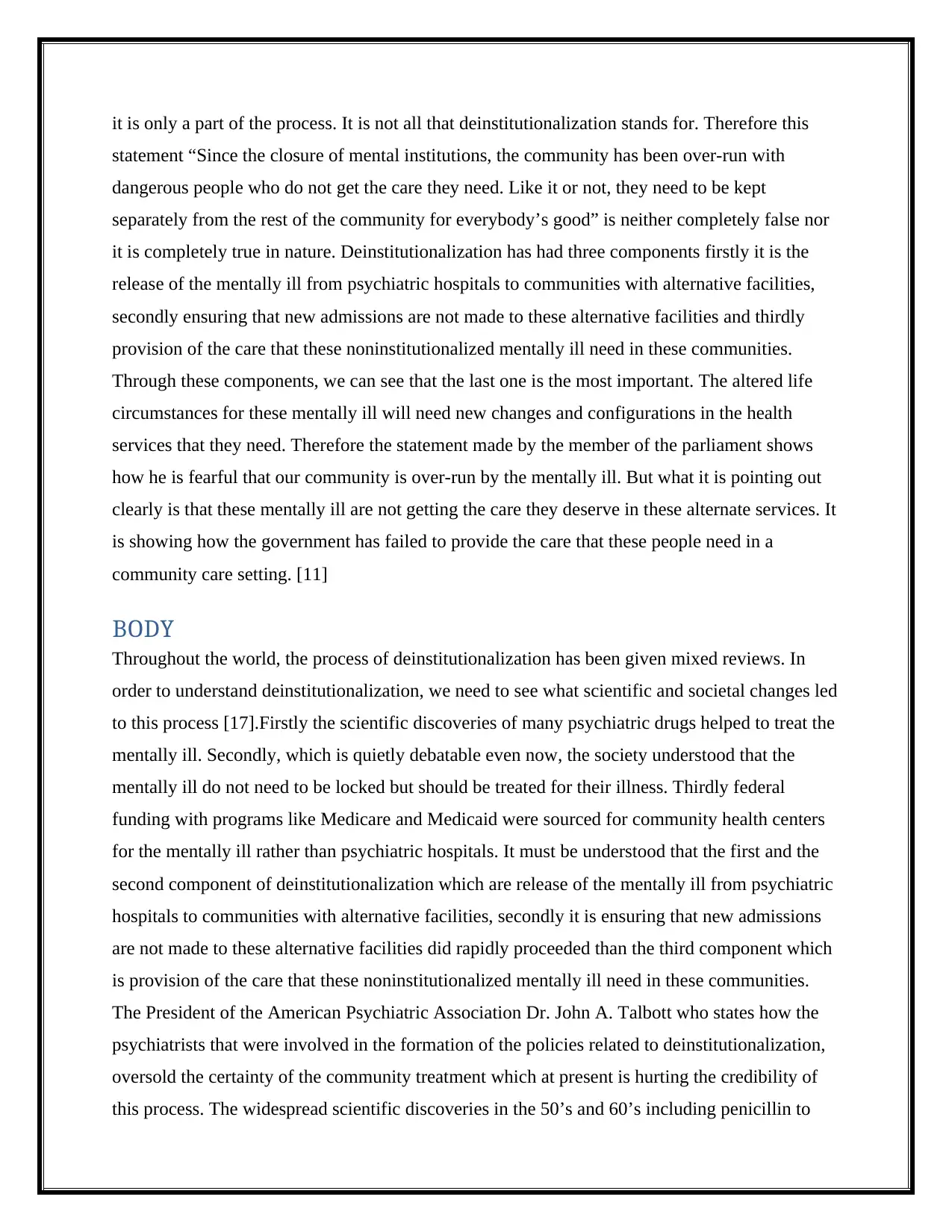
it is only a part of the process. It is not all that deinstitutionalization stands for. Therefore this
statement “Since the closure of mental institutions, the community has been over-run with
dangerous people who do not get the care they need. Like it or not, they need to be kept
separately from the rest of the community for everybody’s good” is neither completely false nor
it is completely true in nature. Deinstitutionalization has had three components firstly it is the
release of the mentally ill from psychiatric hospitals to communities with alternative facilities,
secondly ensuring that new admissions are not made to these alternative facilities and thirdly
provision of the care that these noninstitutionalized mentally ill need in these communities.
Through these components, we can see that the last one is the most important. The altered life
circumstances for these mentally ill will need new changes and configurations in the health
services that they need. Therefore the statement made by the member of the parliament shows
how he is fearful that our community is over-run by the mentally ill. But what it is pointing out
clearly is that these mentally ill are not getting the care they deserve in these alternate services. It
is showing how the government has failed to provide the care that these people need in a
community care setting. [11]
BODY
Throughout the world, the process of deinstitutionalization has been given mixed reviews. In
order to understand deinstitutionalization, we need to see what scientific and societal changes led
to this process [17].Firstly the scientific discoveries of many psychiatric drugs helped to treat the
mentally ill. Secondly, which is quietly debatable even now, the society understood that the
mentally ill do not need to be locked but should be treated for their illness. Thirdly federal
funding with programs like Medicare and Medicaid were sourced for community health centers
for the mentally ill rather than psychiatric hospitals. It must be understood that the first and the
second component of deinstitutionalization which are release of the mentally ill from psychiatric
hospitals to communities with alternative facilities, secondly it is ensuring that new admissions
are not made to these alternative facilities did rapidly proceeded than the third component which
is provision of the care that these noninstitutionalized mentally ill need in these communities.
The President of the American Psychiatric Association Dr. John A. Talbott who states how the
psychiatrists that were involved in the formation of the policies related to deinstitutionalization,
oversold the certainty of the community treatment which at present is hurting the credibility of
this process. The widespread scientific discoveries in the 50’s and 60’s including penicillin to
statement “Since the closure of mental institutions, the community has been over-run with
dangerous people who do not get the care they need. Like it or not, they need to be kept
separately from the rest of the community for everybody’s good” is neither completely false nor
it is completely true in nature. Deinstitutionalization has had three components firstly it is the
release of the mentally ill from psychiatric hospitals to communities with alternative facilities,
secondly ensuring that new admissions are not made to these alternative facilities and thirdly
provision of the care that these noninstitutionalized mentally ill need in these communities.
Through these components, we can see that the last one is the most important. The altered life
circumstances for these mentally ill will need new changes and configurations in the health
services that they need. Therefore the statement made by the member of the parliament shows
how he is fearful that our community is over-run by the mentally ill. But what it is pointing out
clearly is that these mentally ill are not getting the care they deserve in these alternate services. It
is showing how the government has failed to provide the care that these people need in a
community care setting. [11]
BODY
Throughout the world, the process of deinstitutionalization has been given mixed reviews. In
order to understand deinstitutionalization, we need to see what scientific and societal changes led
to this process [17].Firstly the scientific discoveries of many psychiatric drugs helped to treat the
mentally ill. Secondly, which is quietly debatable even now, the society understood that the
mentally ill do not need to be locked but should be treated for their illness. Thirdly federal
funding with programs like Medicare and Medicaid were sourced for community health centers
for the mentally ill rather than psychiatric hospitals. It must be understood that the first and the
second component of deinstitutionalization which are release of the mentally ill from psychiatric
hospitals to communities with alternative facilities, secondly it is ensuring that new admissions
are not made to these alternative facilities did rapidly proceeded than the third component which
is provision of the care that these noninstitutionalized mentally ill need in these communities.
The President of the American Psychiatric Association Dr. John A. Talbott who states how the
psychiatrists that were involved in the formation of the policies related to deinstitutionalization,
oversold the certainty of the community treatment which at present is hurting the credibility of
this process. The widespread scientific discoveries in the 50’s and 60’s including penicillin to
Paraphrase This Document
Need a fresh take? Get an instant paraphrase of this document with our AI Paraphraser
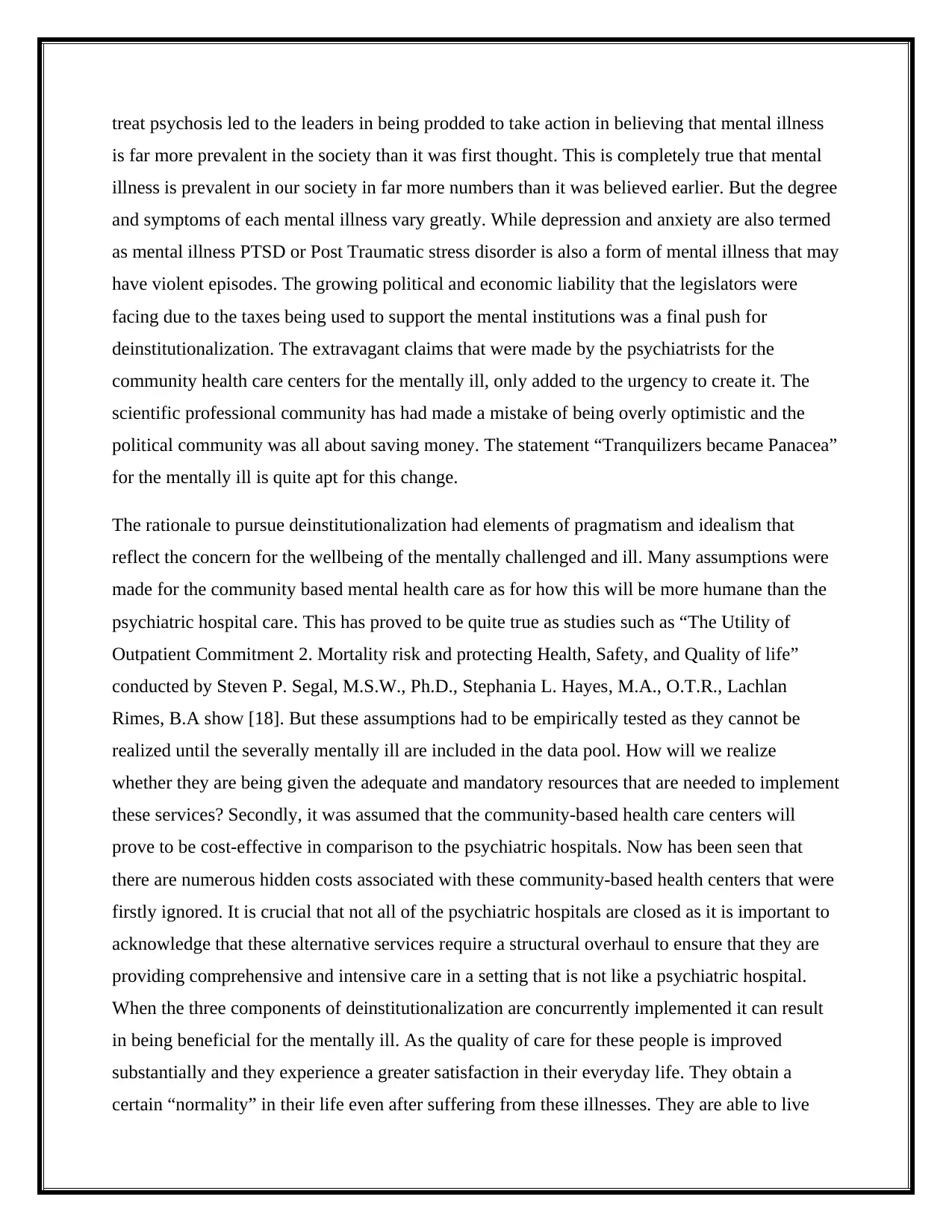
treat psychosis led to the leaders in being prodded to take action in believing that mental illness
is far more prevalent in the society than it was first thought. This is completely true that mental
illness is prevalent in our society in far more numbers than it was believed earlier. But the degree
and symptoms of each mental illness vary greatly. While depression and anxiety are also termed
as mental illness PTSD or Post Traumatic stress disorder is also a form of mental illness that may
have violent episodes. The growing political and economic liability that the legislators were
facing due to the taxes being used to support the mental institutions was a final push for
deinstitutionalization. The extravagant claims that were made by the psychiatrists for the
community health care centers for the mentally ill, only added to the urgency to create it. The
scientific professional community has had made a mistake of being overly optimistic and the
political community was all about saving money. The statement “Tranquilizers became Panacea”
for the mentally ill is quite apt for this change.
The rationale to pursue deinstitutionalization had elements of pragmatism and idealism that
reflect the concern for the wellbeing of the mentally challenged and ill. Many assumptions were
made for the community based mental health care as for how this will be more humane than the
psychiatric hospital care. This has proved to be quite true as studies such as “The Utility of
Outpatient Commitment 2. Mortality risk and protecting Health, Safety, and Quality of life”
conducted by Steven P. Segal, M.S.W., Ph.D., Stephania L. Hayes, M.A., O.T.R., Lachlan
Rimes, B.A show [18]. But these assumptions had to be empirically tested as they cannot be
realized until the severally mentally ill are included in the data pool. How will we realize
whether they are being given the adequate and mandatory resources that are needed to implement
these services? Secondly, it was assumed that the community-based health care centers will
prove to be cost-effective in comparison to the psychiatric hospitals. Now has been seen that
there are numerous hidden costs associated with these community-based health centers that were
firstly ignored. It is crucial that not all of the psychiatric hospitals are closed as it is important to
acknowledge that these alternative services require a structural overhaul to ensure that they are
providing comprehensive and intensive care in a setting that is not like a psychiatric hospital.
When the three components of deinstitutionalization are concurrently implemented it can result
in being beneficial for the mentally ill. As the quality of care for these people is improved
substantially and they experience a greater satisfaction in their everyday life. They obtain a
certain “normality” in their life even after suffering from these illnesses. They are able to live
is far more prevalent in the society than it was first thought. This is completely true that mental
illness is prevalent in our society in far more numbers than it was believed earlier. But the degree
and symptoms of each mental illness vary greatly. While depression and anxiety are also termed
as mental illness PTSD or Post Traumatic stress disorder is also a form of mental illness that may
have violent episodes. The growing political and economic liability that the legislators were
facing due to the taxes being used to support the mental institutions was a final push for
deinstitutionalization. The extravagant claims that were made by the psychiatrists for the
community health care centers for the mentally ill, only added to the urgency to create it. The
scientific professional community has had made a mistake of being overly optimistic and the
political community was all about saving money. The statement “Tranquilizers became Panacea”
for the mentally ill is quite apt for this change.
The rationale to pursue deinstitutionalization had elements of pragmatism and idealism that
reflect the concern for the wellbeing of the mentally challenged and ill. Many assumptions were
made for the community based mental health care as for how this will be more humane than the
psychiatric hospital care. This has proved to be quite true as studies such as “The Utility of
Outpatient Commitment 2. Mortality risk and protecting Health, Safety, and Quality of life”
conducted by Steven P. Segal, M.S.W., Ph.D., Stephania L. Hayes, M.A., O.T.R., Lachlan
Rimes, B.A show [18]. But these assumptions had to be empirically tested as they cannot be
realized until the severally mentally ill are included in the data pool. How will we realize
whether they are being given the adequate and mandatory resources that are needed to implement
these services? Secondly, it was assumed that the community-based health care centers will
prove to be cost-effective in comparison to the psychiatric hospitals. Now has been seen that
there are numerous hidden costs associated with these community-based health centers that were
firstly ignored. It is crucial that not all of the psychiatric hospitals are closed as it is important to
acknowledge that these alternative services require a structural overhaul to ensure that they are
providing comprehensive and intensive care in a setting that is not like a psychiatric hospital.
When the three components of deinstitutionalization are concurrently implemented it can result
in being beneficial for the mentally ill. As the quality of care for these people is improved
substantially and they experience a greater satisfaction in their everyday life. They obtain a
certain “normality” in their life even after suffering from these illnesses. They are able to live
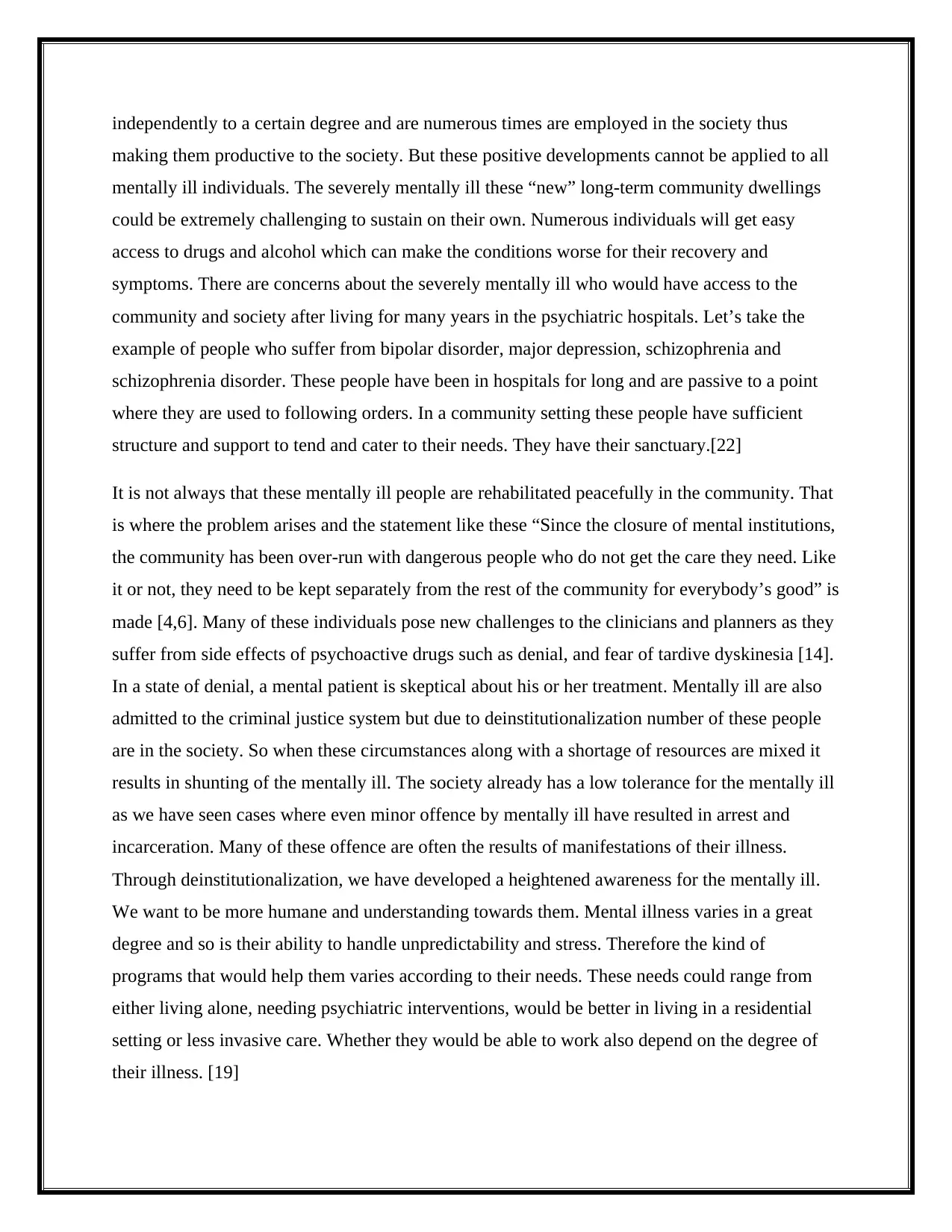
independently to a certain degree and are numerous times are employed in the society thus
making them productive to the society. But these positive developments cannot be applied to all
mentally ill individuals. The severely mentally ill these “new” long-term community dwellings
could be extremely challenging to sustain on their own. Numerous individuals will get easy
access to drugs and alcohol which can make the conditions worse for their recovery and
symptoms. There are concerns about the severely mentally ill who would have access to the
community and society after living for many years in the psychiatric hospitals. Let’s take the
example of people who suffer from bipolar disorder, major depression, schizophrenia and
schizophrenia disorder. These people have been in hospitals for long and are passive to a point
where they are used to following orders. In a community setting these people have sufficient
structure and support to tend and cater to their needs. They have their sanctuary.[22]
It is not always that these mentally ill people are rehabilitated peacefully in the community. That
is where the problem arises and the statement like these “Since the closure of mental institutions,
the community has been over-run with dangerous people who do not get the care they need. Like
it or not, they need to be kept separately from the rest of the community for everybody’s good” is
made [4,6]. Many of these individuals pose new challenges to the clinicians and planners as they
suffer from side effects of psychoactive drugs such as denial, and fear of tardive dyskinesia [14].
In a state of denial, a mental patient is skeptical about his or her treatment. Mentally ill are also
admitted to the criminal justice system but due to deinstitutionalization number of these people
are in the society. So when these circumstances along with a shortage of resources are mixed it
results in shunting of the mentally ill. The society already has a low tolerance for the mentally ill
as we have seen cases where even minor offence by mentally ill have resulted in arrest and
incarceration. Many of these offence are often the results of manifestations of their illness.
Through deinstitutionalization, we have developed a heightened awareness for the mentally ill.
We want to be more humane and understanding towards them. Mental illness varies in a great
degree and so is their ability to handle unpredictability and stress. Therefore the kind of
programs that would help them varies according to their needs. These needs could range from
either living alone, needing psychiatric interventions, would be better in living in a residential
setting or less invasive care. Whether they would be able to work also depend on the degree of
their illness. [19]
making them productive to the society. But these positive developments cannot be applied to all
mentally ill individuals. The severely mentally ill these “new” long-term community dwellings
could be extremely challenging to sustain on their own. Numerous individuals will get easy
access to drugs and alcohol which can make the conditions worse for their recovery and
symptoms. There are concerns about the severely mentally ill who would have access to the
community and society after living for many years in the psychiatric hospitals. Let’s take the
example of people who suffer from bipolar disorder, major depression, schizophrenia and
schizophrenia disorder. These people have been in hospitals for long and are passive to a point
where they are used to following orders. In a community setting these people have sufficient
structure and support to tend and cater to their needs. They have their sanctuary.[22]
It is not always that these mentally ill people are rehabilitated peacefully in the community. That
is where the problem arises and the statement like these “Since the closure of mental institutions,
the community has been over-run with dangerous people who do not get the care they need. Like
it or not, they need to be kept separately from the rest of the community for everybody’s good” is
made [4,6]. Many of these individuals pose new challenges to the clinicians and planners as they
suffer from side effects of psychoactive drugs such as denial, and fear of tardive dyskinesia [14].
In a state of denial, a mental patient is skeptical about his or her treatment. Mentally ill are also
admitted to the criminal justice system but due to deinstitutionalization number of these people
are in the society. So when these circumstances along with a shortage of resources are mixed it
results in shunting of the mentally ill. The society already has a low tolerance for the mentally ill
as we have seen cases where even minor offence by mentally ill have resulted in arrest and
incarceration. Many of these offence are often the results of manifestations of their illness.
Through deinstitutionalization, we have developed a heightened awareness for the mentally ill.
We want to be more humane and understanding towards them. Mental illness varies in a great
degree and so is their ability to handle unpredictability and stress. Therefore the kind of
programs that would help them varies according to their needs. These needs could range from
either living alone, needing psychiatric interventions, would be better in living in a residential
setting or less invasive care. Whether they would be able to work also depend on the degree of
their illness. [19]
⊘ This is a preview!⊘
Do you want full access?
Subscribe today to unlock all pages.

Trusted by 1+ million students worldwide
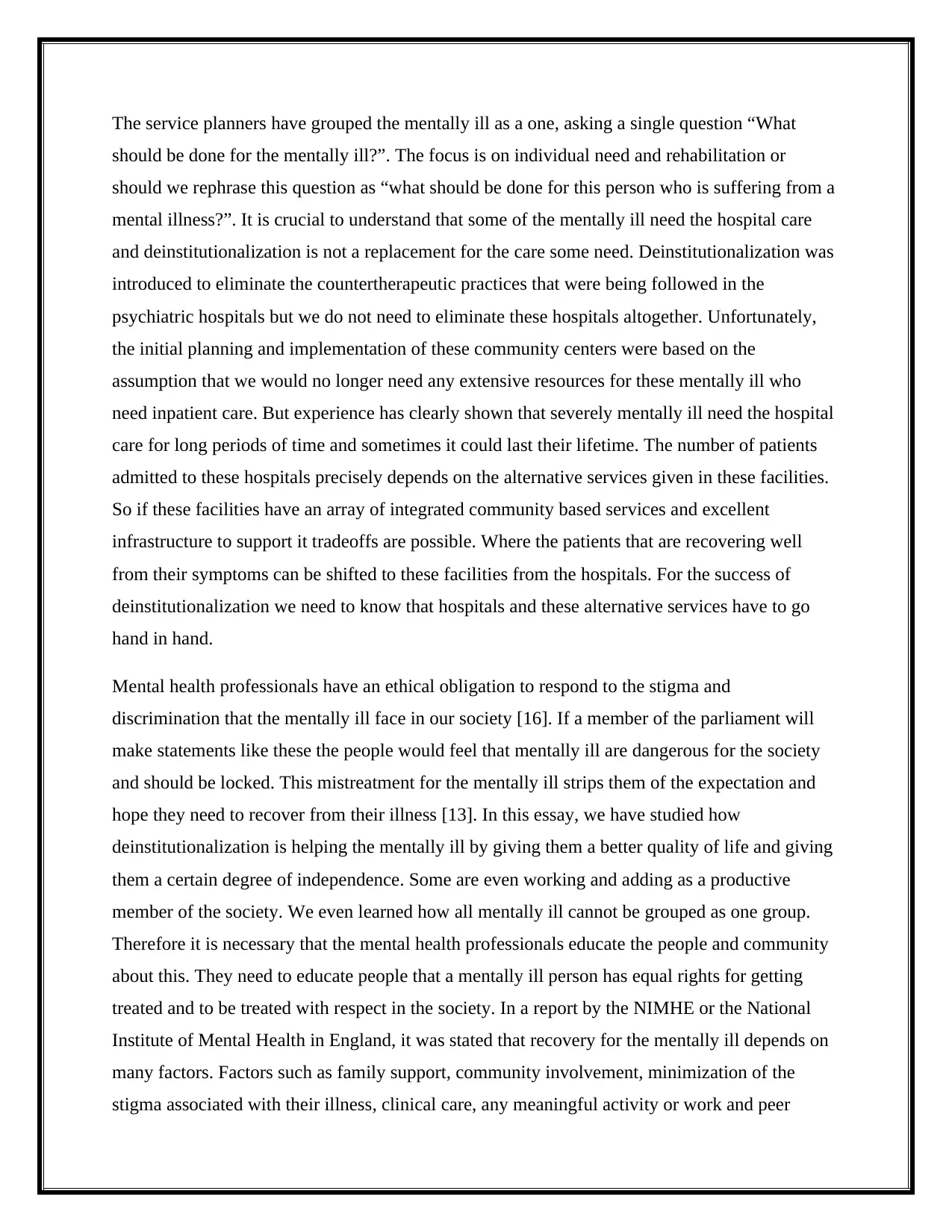
The service planners have grouped the mentally ill as a one, asking a single question “What
should be done for the mentally ill?”. The focus is on individual need and rehabilitation or
should we rephrase this question as “what should be done for this person who is suffering from a
mental illness?”. It is crucial to understand that some of the mentally ill need the hospital care
and deinstitutionalization is not a replacement for the care some need. Deinstitutionalization was
introduced to eliminate the countertherapeutic practices that were being followed in the
psychiatric hospitals but we do not need to eliminate these hospitals altogether. Unfortunately,
the initial planning and implementation of these community centers were based on the
assumption that we would no longer need any extensive resources for these mentally ill who
need inpatient care. But experience has clearly shown that severely mentally ill need the hospital
care for long periods of time and sometimes it could last their lifetime. The number of patients
admitted to these hospitals precisely depends on the alternative services given in these facilities.
So if these facilities have an array of integrated community based services and excellent
infrastructure to support it tradeoffs are possible. Where the patients that are recovering well
from their symptoms can be shifted to these facilities from the hospitals. For the success of
deinstitutionalization we need to know that hospitals and these alternative services have to go
hand in hand.
Mental health professionals have an ethical obligation to respond to the stigma and
discrimination that the mentally ill face in our society [16]. If a member of the parliament will
make statements like these the people would feel that mentally ill are dangerous for the society
and should be locked. This mistreatment for the mentally ill strips them of the expectation and
hope they need to recover from their illness [13]. In this essay, we have studied how
deinstitutionalization is helping the mentally ill by giving them a better quality of life and giving
them a certain degree of independence. Some are even working and adding as a productive
member of the society. We even learned how all mentally ill cannot be grouped as one group.
Therefore it is necessary that the mental health professionals educate the people and community
about this. They need to educate people that a mentally ill person has equal rights for getting
treated and to be treated with respect in the society. In a report by the NIMHE or the National
Institute of Mental Health in England, it was stated that recovery for the mentally ill depends on
many factors. Factors such as family support, community involvement, minimization of the
stigma associated with their illness, clinical care, any meaningful activity or work and peer
should be done for the mentally ill?”. The focus is on individual need and rehabilitation or
should we rephrase this question as “what should be done for this person who is suffering from a
mental illness?”. It is crucial to understand that some of the mentally ill need the hospital care
and deinstitutionalization is not a replacement for the care some need. Deinstitutionalization was
introduced to eliminate the countertherapeutic practices that were being followed in the
psychiatric hospitals but we do not need to eliminate these hospitals altogether. Unfortunately,
the initial planning and implementation of these community centers were based on the
assumption that we would no longer need any extensive resources for these mentally ill who
need inpatient care. But experience has clearly shown that severely mentally ill need the hospital
care for long periods of time and sometimes it could last their lifetime. The number of patients
admitted to these hospitals precisely depends on the alternative services given in these facilities.
So if these facilities have an array of integrated community based services and excellent
infrastructure to support it tradeoffs are possible. Where the patients that are recovering well
from their symptoms can be shifted to these facilities from the hospitals. For the success of
deinstitutionalization we need to know that hospitals and these alternative services have to go
hand in hand.
Mental health professionals have an ethical obligation to respond to the stigma and
discrimination that the mentally ill face in our society [16]. If a member of the parliament will
make statements like these the people would feel that mentally ill are dangerous for the society
and should be locked. This mistreatment for the mentally ill strips them of the expectation and
hope they need to recover from their illness [13]. In this essay, we have studied how
deinstitutionalization is helping the mentally ill by giving them a better quality of life and giving
them a certain degree of independence. Some are even working and adding as a productive
member of the society. We even learned how all mentally ill cannot be grouped as one group.
Therefore it is necessary that the mental health professionals educate the people and community
about this. They need to educate people that a mentally ill person has equal rights for getting
treated and to be treated with respect in the society. In a report by the NIMHE or the National
Institute of Mental Health in England, it was stated that recovery for the mentally ill depends on
many factors. Factors such as family support, community involvement, minimization of the
stigma associated with their illness, clinical care, any meaningful activity or work and peer
Paraphrase This Document
Need a fresh take? Get an instant paraphrase of this document with our AI Paraphraser
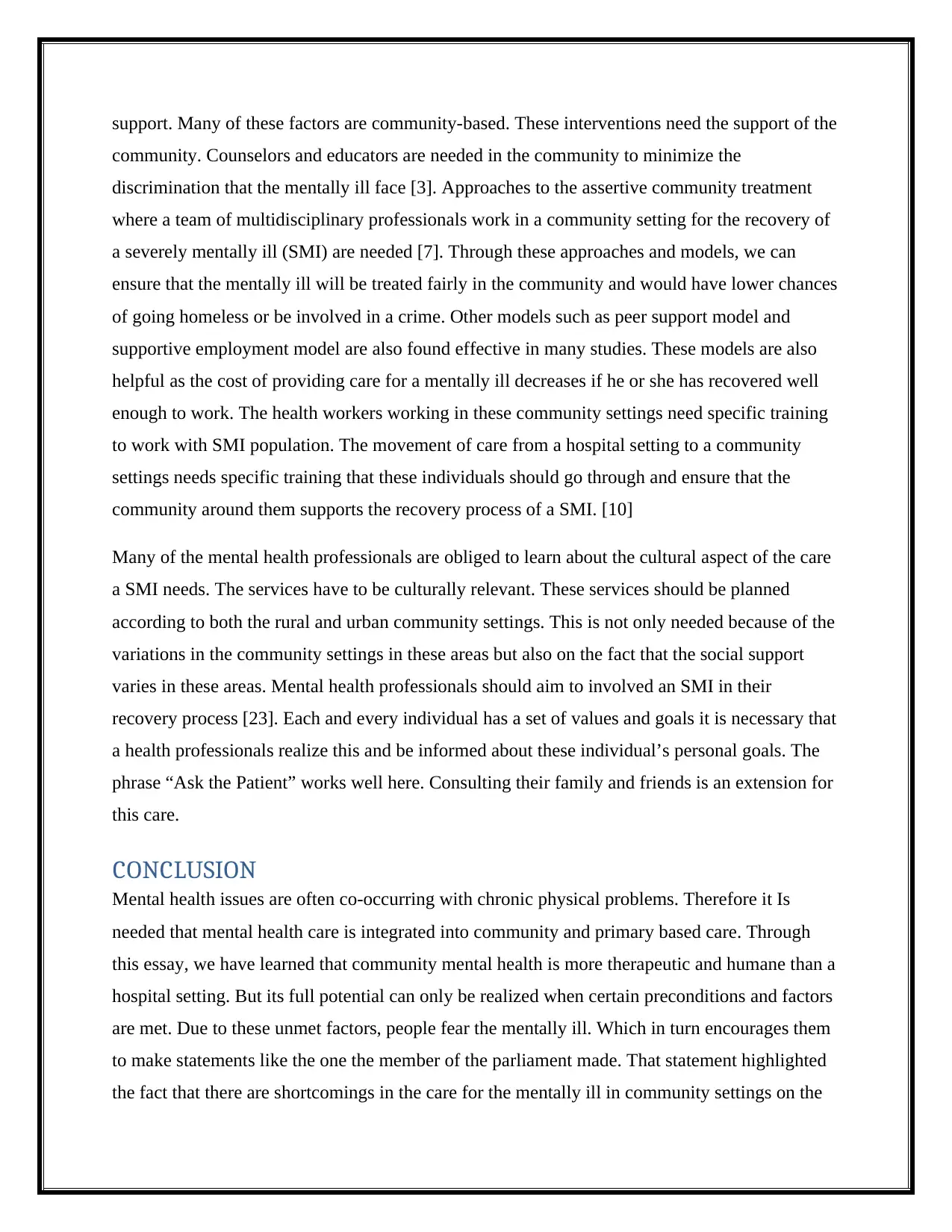
support. Many of these factors are community-based. These interventions need the support of the
community. Counselors and educators are needed in the community to minimize the
discrimination that the mentally ill face [3]. Approaches to the assertive community treatment
where a team of multidisciplinary professionals work in a community setting for the recovery of
a severely mentally ill (SMI) are needed [7]. Through these approaches and models, we can
ensure that the mentally ill will be treated fairly in the community and would have lower chances
of going homeless or be involved in a crime. Other models such as peer support model and
supportive employment model are also found effective in many studies. These models are also
helpful as the cost of providing care for a mentally ill decreases if he or she has recovered well
enough to work. The health workers working in these community settings need specific training
to work with SMI population. The movement of care from a hospital setting to a community
settings needs specific training that these individuals should go through and ensure that the
community around them supports the recovery process of a SMI. [10]
Many of the mental health professionals are obliged to learn about the cultural aspect of the care
a SMI needs. The services have to be culturally relevant. These services should be planned
according to both the rural and urban community settings. This is not only needed because of the
variations in the community settings in these areas but also on the fact that the social support
varies in these areas. Mental health professionals should aim to involved an SMI in their
recovery process [23]. Each and every individual has a set of values and goals it is necessary that
a health professionals realize this and be informed about these individual’s personal goals. The
phrase “Ask the Patient” works well here. Consulting their family and friends is an extension for
this care.
CONCLUSION
Mental health issues are often co-occurring with chronic physical problems. Therefore it Is
needed that mental health care is integrated into community and primary based care. Through
this essay, we have learned that community mental health is more therapeutic and humane than a
hospital setting. But its full potential can only be realized when certain preconditions and factors
are met. Due to these unmet factors, people fear the mentally ill. Which in turn encourages them
to make statements like the one the member of the parliament made. That statement highlighted
the fact that there are shortcomings in the care for the mentally ill in community settings on the
community. Counselors and educators are needed in the community to minimize the
discrimination that the mentally ill face [3]. Approaches to the assertive community treatment
where a team of multidisciplinary professionals work in a community setting for the recovery of
a severely mentally ill (SMI) are needed [7]. Through these approaches and models, we can
ensure that the mentally ill will be treated fairly in the community and would have lower chances
of going homeless or be involved in a crime. Other models such as peer support model and
supportive employment model are also found effective in many studies. These models are also
helpful as the cost of providing care for a mentally ill decreases if he or she has recovered well
enough to work. The health workers working in these community settings need specific training
to work with SMI population. The movement of care from a hospital setting to a community
settings needs specific training that these individuals should go through and ensure that the
community around them supports the recovery process of a SMI. [10]
Many of the mental health professionals are obliged to learn about the cultural aspect of the care
a SMI needs. The services have to be culturally relevant. These services should be planned
according to both the rural and urban community settings. This is not only needed because of the
variations in the community settings in these areas but also on the fact that the social support
varies in these areas. Mental health professionals should aim to involved an SMI in their
recovery process [23]. Each and every individual has a set of values and goals it is necessary that
a health professionals realize this and be informed about these individual’s personal goals. The
phrase “Ask the Patient” works well here. Consulting their family and friends is an extension for
this care.
CONCLUSION
Mental health issues are often co-occurring with chronic physical problems. Therefore it Is
needed that mental health care is integrated into community and primary based care. Through
this essay, we have learned that community mental health is more therapeutic and humane than a
hospital setting. But its full potential can only be realized when certain preconditions and factors
are met. Due to these unmet factors, people fear the mentally ill. Which in turn encourages them
to make statements like the one the member of the parliament made. That statement highlighted
the fact that there are shortcomings in the care for the mentally ill in community settings on the
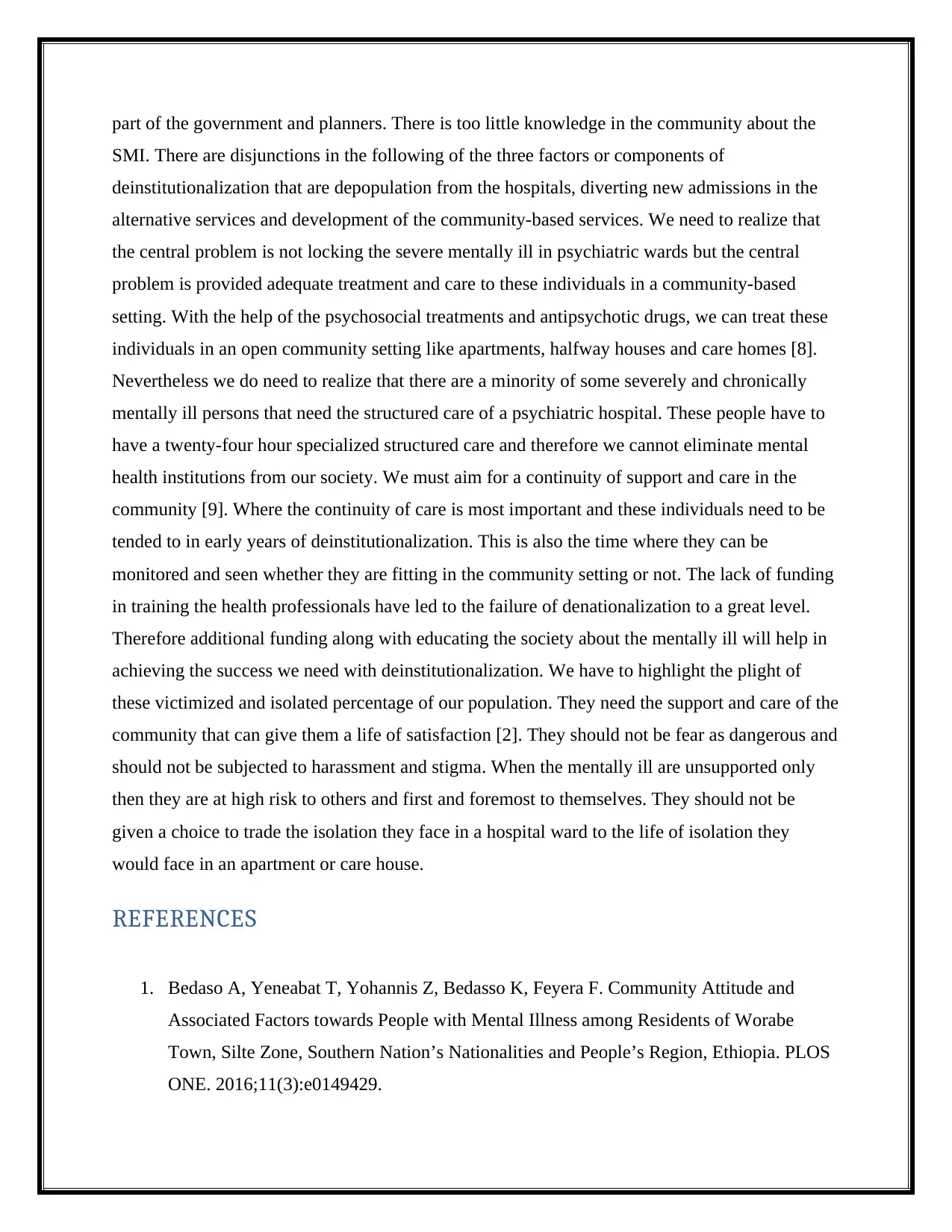
part of the government and planners. There is too little knowledge in the community about the
SMI. There are disjunctions in the following of the three factors or components of
deinstitutionalization that are depopulation from the hospitals, diverting new admissions in the
alternative services and development of the community-based services. We need to realize that
the central problem is not locking the severe mentally ill in psychiatric wards but the central
problem is provided adequate treatment and care to these individuals in a community-based
setting. With the help of the psychosocial treatments and antipsychotic drugs, we can treat these
individuals in an open community setting like apartments, halfway houses and care homes [8].
Nevertheless we do need to realize that there are a minority of some severely and chronically
mentally ill persons that need the structured care of a psychiatric hospital. These people have to
have a twenty-four hour specialized structured care and therefore we cannot eliminate mental
health institutions from our society. We must aim for a continuity of support and care in the
community [9]. Where the continuity of care is most important and these individuals need to be
tended to in early years of deinstitutionalization. This is also the time where they can be
monitored and seen whether they are fitting in the community setting or not. The lack of funding
in training the health professionals have led to the failure of denationalization to a great level.
Therefore additional funding along with educating the society about the mentally ill will help in
achieving the success we need with deinstitutionalization. We have to highlight the plight of
these victimized and isolated percentage of our population. They need the support and care of the
community that can give them a life of satisfaction [2]. They should not be fear as dangerous and
should not be subjected to harassment and stigma. When the mentally ill are unsupported only
then they are at high risk to others and first and foremost to themselves. They should not be
given a choice to trade the isolation they face in a hospital ward to the life of isolation they
would face in an apartment or care house.
REFERENCES
1. Bedaso A, Yeneabat T, Yohannis Z, Bedasso K, Feyera F. Community Attitude and
Associated Factors towards People with Mental Illness among Residents of Worabe
Town, Silte Zone, Southern Nation’s Nationalities and People’s Region, Ethiopia. PLOS
ONE. 2016;11(3):e0149429.
SMI. There are disjunctions in the following of the three factors or components of
deinstitutionalization that are depopulation from the hospitals, diverting new admissions in the
alternative services and development of the community-based services. We need to realize that
the central problem is not locking the severe mentally ill in psychiatric wards but the central
problem is provided adequate treatment and care to these individuals in a community-based
setting. With the help of the psychosocial treatments and antipsychotic drugs, we can treat these
individuals in an open community setting like apartments, halfway houses and care homes [8].
Nevertheless we do need to realize that there are a minority of some severely and chronically
mentally ill persons that need the structured care of a psychiatric hospital. These people have to
have a twenty-four hour specialized structured care and therefore we cannot eliminate mental
health institutions from our society. We must aim for a continuity of support and care in the
community [9]. Where the continuity of care is most important and these individuals need to be
tended to in early years of deinstitutionalization. This is also the time where they can be
monitored and seen whether they are fitting in the community setting or not. The lack of funding
in training the health professionals have led to the failure of denationalization to a great level.
Therefore additional funding along with educating the society about the mentally ill will help in
achieving the success we need with deinstitutionalization. We have to highlight the plight of
these victimized and isolated percentage of our population. They need the support and care of the
community that can give them a life of satisfaction [2]. They should not be fear as dangerous and
should not be subjected to harassment and stigma. When the mentally ill are unsupported only
then they are at high risk to others and first and foremost to themselves. They should not be
given a choice to trade the isolation they face in a hospital ward to the life of isolation they
would face in an apartment or care house.
REFERENCES
1. Bedaso A, Yeneabat T, Yohannis Z, Bedasso K, Feyera F. Community Attitude and
Associated Factors towards People with Mental Illness among Residents of Worabe
Town, Silte Zone, Southern Nation’s Nationalities and People’s Region, Ethiopia. PLOS
ONE. 2016;11(3):e0149429.
⊘ This is a preview!⊘
Do you want full access?
Subscribe today to unlock all pages.

Trusted by 1+ million students worldwide
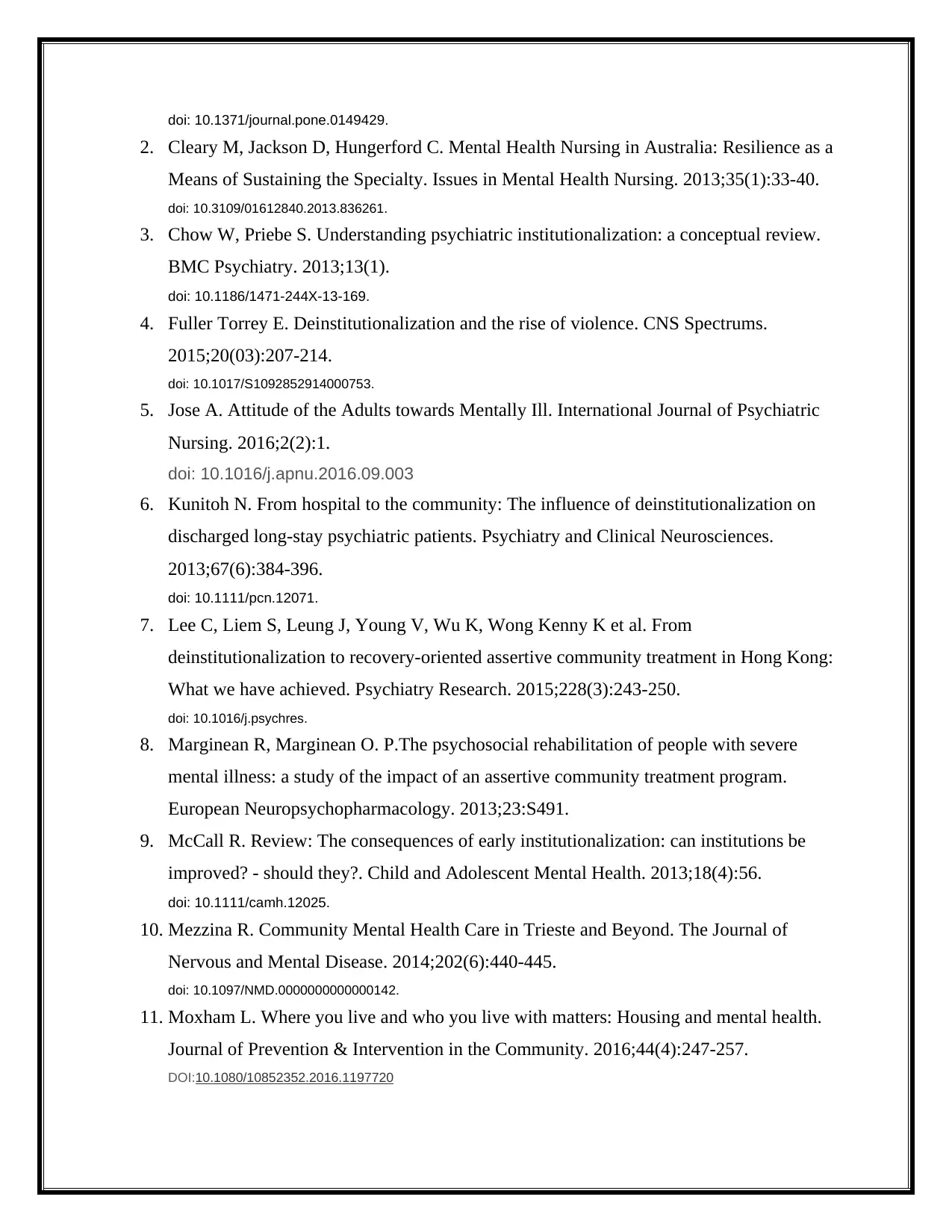
doi: 10.1371/journal.pone.0149429.
2. Cleary M, Jackson D, Hungerford C. Mental Health Nursing in Australia: Resilience as a
Means of Sustaining the Specialty. Issues in Mental Health Nursing. 2013;35(1):33-40.
doi: 10.3109/01612840.2013.836261.
3. Chow W, Priebe S. Understanding psychiatric institutionalization: a conceptual review.
BMC Psychiatry. 2013;13(1).
doi: 10.1186/1471-244X-13-169.
4. Fuller Torrey E. Deinstitutionalization and the rise of violence. CNS Spectrums.
2015;20(03):207-214.
doi: 10.1017/S1092852914000753.
5. Jose A. Attitude of the Adults towards Mentally Ill. International Journal of Psychiatric
Nursing. 2016;2(2):1.
doi: 10.1016/j.apnu.2016.09.003
6. Kunitoh N. From hospital to the community: The influence of deinstitutionalization on
discharged long-stay psychiatric patients. Psychiatry and Clinical Neurosciences.
2013;67(6):384-396.
doi: 10.1111/pcn.12071.
7. Lee C, Liem S, Leung J, Young V, Wu K, Wong Kenny K et al. From
deinstitutionalization to recovery-oriented assertive community treatment in Hong Kong:
What we have achieved. Psychiatry Research. 2015;228(3):243-250.
doi: 10.1016/j.psychres.
8. Marginean R, Marginean O. P.The psychosocial rehabilitation of people with severe
mental illness: a study of the impact of an assertive community treatment program.
European Neuropsychopharmacology. 2013;23:S491.
9. McCall R. Review: The consequences of early institutionalization: can institutions be
improved? - should they?. Child and Adolescent Mental Health. 2013;18(4):56.
doi: 10.1111/camh.12025.
10. Mezzina R. Community Mental Health Care in Trieste and Beyond. The Journal of
Nervous and Mental Disease. 2014;202(6):440-445.
doi: 10.1097/NMD.0000000000000142.
11. Moxham L. Where you live and who you live with matters: Housing and mental health.
Journal of Prevention & Intervention in the Community. 2016;44(4):247-257.
DOI:10.1080/10852352.2016.1197720
2. Cleary M, Jackson D, Hungerford C. Mental Health Nursing in Australia: Resilience as a
Means of Sustaining the Specialty. Issues in Mental Health Nursing. 2013;35(1):33-40.
doi: 10.3109/01612840.2013.836261.
3. Chow W, Priebe S. Understanding psychiatric institutionalization: a conceptual review.
BMC Psychiatry. 2013;13(1).
doi: 10.1186/1471-244X-13-169.
4. Fuller Torrey E. Deinstitutionalization and the rise of violence. CNS Spectrums.
2015;20(03):207-214.
doi: 10.1017/S1092852914000753.
5. Jose A. Attitude of the Adults towards Mentally Ill. International Journal of Psychiatric
Nursing. 2016;2(2):1.
doi: 10.1016/j.apnu.2016.09.003
6. Kunitoh N. From hospital to the community: The influence of deinstitutionalization on
discharged long-stay psychiatric patients. Psychiatry and Clinical Neurosciences.
2013;67(6):384-396.
doi: 10.1111/pcn.12071.
7. Lee C, Liem S, Leung J, Young V, Wu K, Wong Kenny K et al. From
deinstitutionalization to recovery-oriented assertive community treatment in Hong Kong:
What we have achieved. Psychiatry Research. 2015;228(3):243-250.
doi: 10.1016/j.psychres.
8. Marginean R, Marginean O. P.The psychosocial rehabilitation of people with severe
mental illness: a study of the impact of an assertive community treatment program.
European Neuropsychopharmacology. 2013;23:S491.
9. McCall R. Review: The consequences of early institutionalization: can institutions be
improved? - should they?. Child and Adolescent Mental Health. 2013;18(4):56.
doi: 10.1111/camh.12025.
10. Mezzina R. Community Mental Health Care in Trieste and Beyond. The Journal of
Nervous and Mental Disease. 2014;202(6):440-445.
doi: 10.1097/NMD.0000000000000142.
11. Moxham L. Where you live and who you live with matters: Housing and mental health.
Journal of Prevention & Intervention in the Community. 2016;44(4):247-257.
DOI:10.1080/10852352.2016.1197720
Paraphrase This Document
Need a fresh take? Get an instant paraphrase of this document with our AI Paraphraser
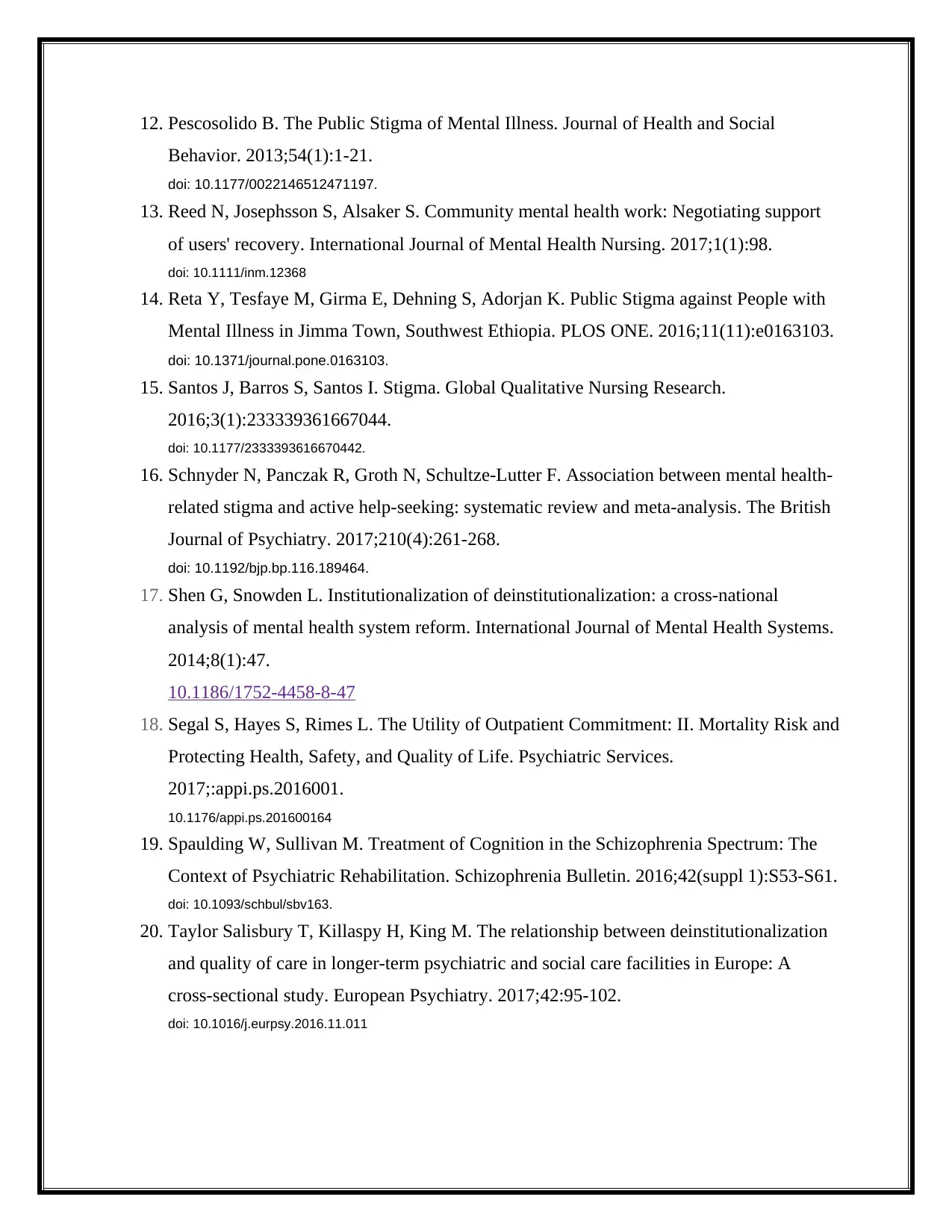
12. Pescosolido B. The Public Stigma of Mental Illness. Journal of Health and Social
Behavior. 2013;54(1):1-21.
doi: 10.1177/0022146512471197.
13. Reed N, Josephsson S, Alsaker S. Community mental health work: Negotiating support
of users' recovery. International Journal of Mental Health Nursing. 2017;1(1):98.
doi: 10.1111/inm.12368
14. Reta Y, Tesfaye M, Girma E, Dehning S, Adorjan K. Public Stigma against People with
Mental Illness in Jimma Town, Southwest Ethiopia. PLOS ONE. 2016;11(11):e0163103.
doi: 10.1371/journal.pone.0163103.
15. Santos J, Barros S, Santos I. Stigma. Global Qualitative Nursing Research.
2016;3(1):233339361667044.
doi: 10.1177/2333393616670442.
16. Schnyder N, Panczak R, Groth N, Schultze-Lutter F. Association between mental health-
related stigma and active help-seeking: systematic review and meta-analysis. The British
Journal of Psychiatry. 2017;210(4):261-268.
doi: 10.1192/bjp.bp.116.189464.
17. Shen G, Snowden L. Institutionalization of deinstitutionalization: a cross-national
analysis of mental health system reform. International Journal of Mental Health Systems.
2014;8(1):47.
10.1186/1752-4458-8-47
18. Segal S, Hayes S, Rimes L. The Utility of Outpatient Commitment: II. Mortality Risk and
Protecting Health, Safety, and Quality of Life. Psychiatric Services.
2017;:appi.ps.2016001.
10.1176/appi.ps.201600164
19. Spaulding W, Sullivan M. Treatment of Cognition in the Schizophrenia Spectrum: The
Context of Psychiatric Rehabilitation. Schizophrenia Bulletin. 2016;42(suppl 1):S53-S61.
doi: 10.1093/schbul/sbv163.
20. Taylor Salisbury T, Killaspy H, King M. The relationship between deinstitutionalization
and quality of care in longer-term psychiatric and social care facilities in Europe: A
cross-sectional study. European Psychiatry. 2017;42:95-102.
doi: 10.1016/j.eurpsy.2016.11.011
Behavior. 2013;54(1):1-21.
doi: 10.1177/0022146512471197.
13. Reed N, Josephsson S, Alsaker S. Community mental health work: Negotiating support
of users' recovery. International Journal of Mental Health Nursing. 2017;1(1):98.
doi: 10.1111/inm.12368
14. Reta Y, Tesfaye M, Girma E, Dehning S, Adorjan K. Public Stigma against People with
Mental Illness in Jimma Town, Southwest Ethiopia. PLOS ONE. 2016;11(11):e0163103.
doi: 10.1371/journal.pone.0163103.
15. Santos J, Barros S, Santos I. Stigma. Global Qualitative Nursing Research.
2016;3(1):233339361667044.
doi: 10.1177/2333393616670442.
16. Schnyder N, Panczak R, Groth N, Schultze-Lutter F. Association between mental health-
related stigma and active help-seeking: systematic review and meta-analysis. The British
Journal of Psychiatry. 2017;210(4):261-268.
doi: 10.1192/bjp.bp.116.189464.
17. Shen G, Snowden L. Institutionalization of deinstitutionalization: a cross-national
analysis of mental health system reform. International Journal of Mental Health Systems.
2014;8(1):47.
10.1186/1752-4458-8-47
18. Segal S, Hayes S, Rimes L. The Utility of Outpatient Commitment: II. Mortality Risk and
Protecting Health, Safety, and Quality of Life. Psychiatric Services.
2017;:appi.ps.2016001.
10.1176/appi.ps.201600164
19. Spaulding W, Sullivan M. Treatment of Cognition in the Schizophrenia Spectrum: The
Context of Psychiatric Rehabilitation. Schizophrenia Bulletin. 2016;42(suppl 1):S53-S61.
doi: 10.1093/schbul/sbv163.
20. Taylor Salisbury T, Killaspy H, King M. The relationship between deinstitutionalization
and quality of care in longer-term psychiatric and social care facilities in Europe: A
cross-sectional study. European Psychiatry. 2017;42:95-102.
doi: 10.1016/j.eurpsy.2016.11.011
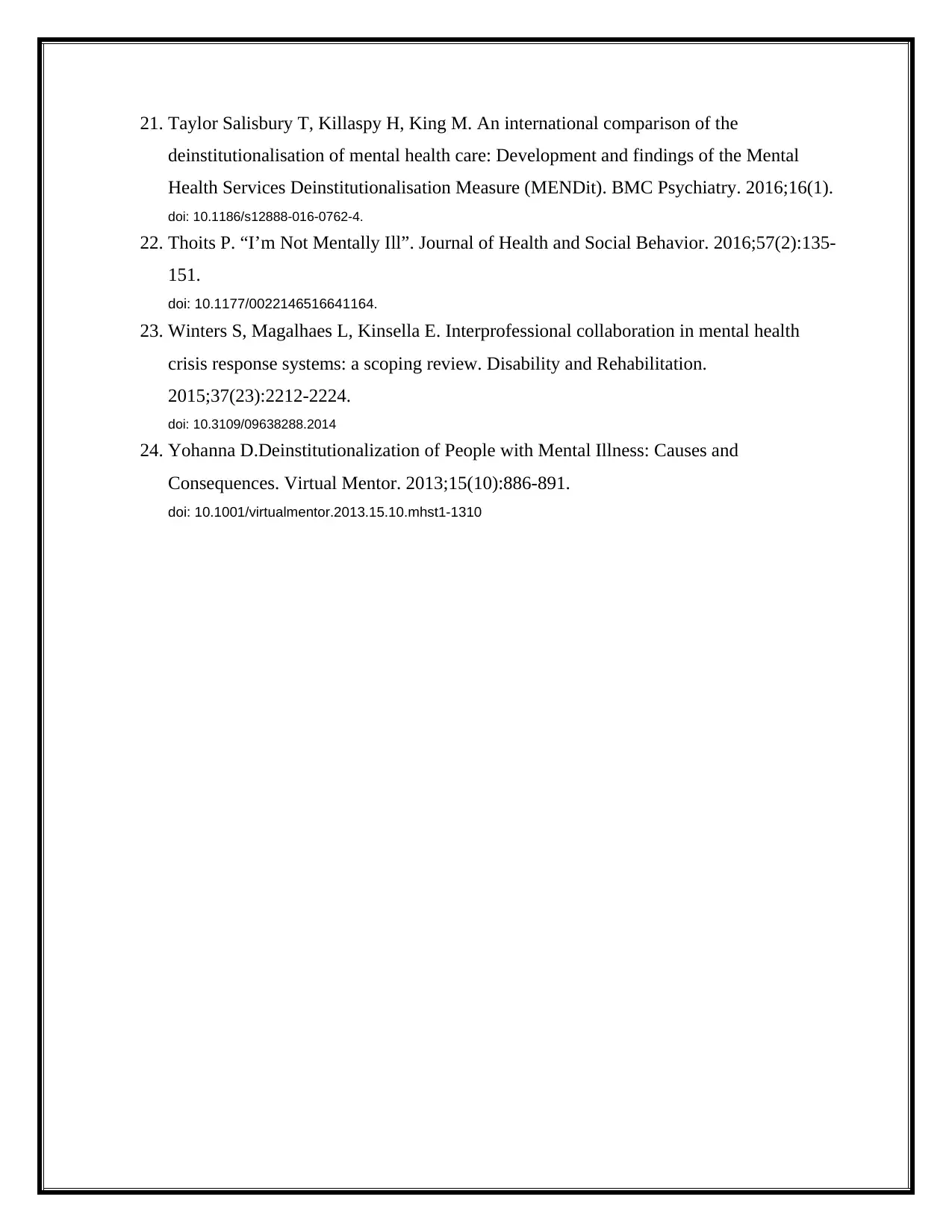
21. Taylor Salisbury T, Killaspy H, King M. An international comparison of the
deinstitutionalisation of mental health care: Development and findings of the Mental
Health Services Deinstitutionalisation Measure (MENDit). BMC Psychiatry. 2016;16(1).
doi: 10.1186/s12888-016-0762-4.
22. Thoits P. “I’m Not Mentally Ill”. Journal of Health and Social Behavior. 2016;57(2):135-
151.
doi: 10.1177/0022146516641164.
23. Winters S, Magalhaes L, Kinsella E. Interprofessional collaboration in mental health
crisis response systems: a scoping review. Disability and Rehabilitation.
2015;37(23):2212-2224.
doi: 10.3109/09638288.2014
24. Yohanna D.Deinstitutionalization of People with Mental Illness: Causes and
Consequences. Virtual Mentor. 2013;15(10):886-891.
doi: 10.1001/virtualmentor.2013.15.10.mhst1-1310
deinstitutionalisation of mental health care: Development and findings of the Mental
Health Services Deinstitutionalisation Measure (MENDit). BMC Psychiatry. 2016;16(1).
doi: 10.1186/s12888-016-0762-4.
22. Thoits P. “I’m Not Mentally Ill”. Journal of Health and Social Behavior. 2016;57(2):135-
151.
doi: 10.1177/0022146516641164.
23. Winters S, Magalhaes L, Kinsella E. Interprofessional collaboration in mental health
crisis response systems: a scoping review. Disability and Rehabilitation.
2015;37(23):2212-2224.
doi: 10.3109/09638288.2014
24. Yohanna D.Deinstitutionalization of People with Mental Illness: Causes and
Consequences. Virtual Mentor. 2013;15(10):886-891.
doi: 10.1001/virtualmentor.2013.15.10.mhst1-1310
⊘ This is a preview!⊘
Do you want full access?
Subscribe today to unlock all pages.

Trusted by 1+ million students worldwide
1 out of 12
Related Documents
Your All-in-One AI-Powered Toolkit for Academic Success.
+13062052269
info@desklib.com
Available 24*7 on WhatsApp / Email
![[object Object]](/_next/static/media/star-bottom.7253800d.svg)
Unlock your academic potential
Copyright © 2020–2025 A2Z Services. All Rights Reserved. Developed and managed by ZUCOL.





